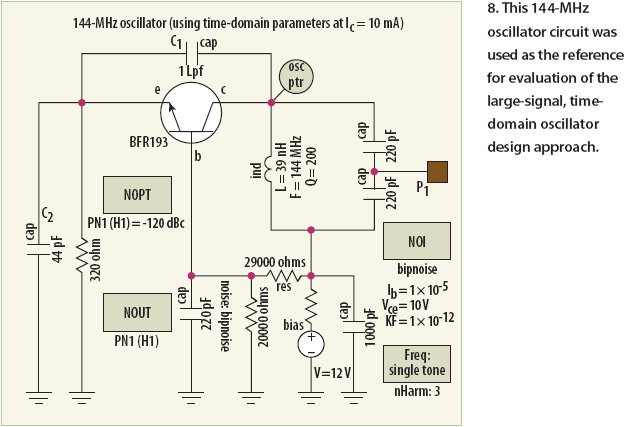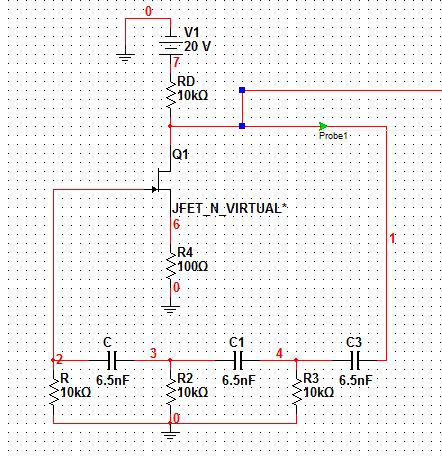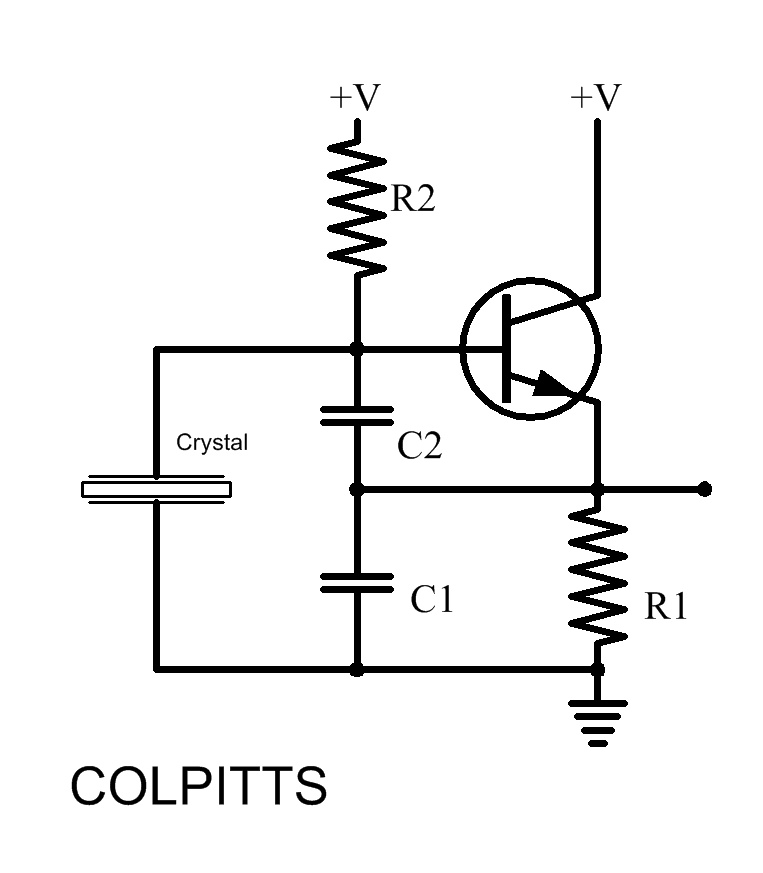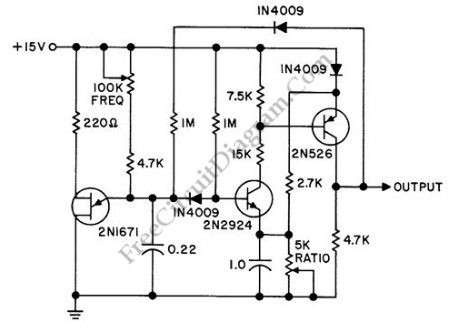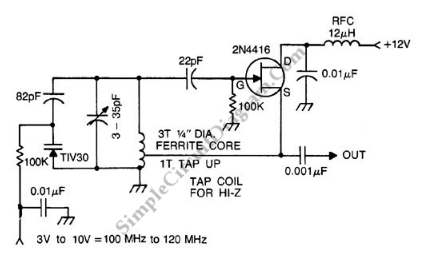
oscillator

The Colpitts oscillator circuit schematic is closely related to the shunt-fed Hartley oscillator, with the primary distinction being in the tank circuit design. In the Colpitts oscillator, two capacitors are utilized in place of divided coils. The basic feedback oscillator is developed using the electrostatic field through a capacitor divider network. The frequency of the Colpitts oscillator is determined by two capacitors connected in series and an inductor. The base voltage is provided by resistors R1 and R2, while the emitter voltage is supplied by R4. The collector voltage is fed back to the positive side of the VCC through resistor R3, which also acts as a collector load. The transistor is configured in an emitter-joint arrangement. When DC power is applied to the circuit, current flows from the negative side of VCC through R4, the transistor Q1, and R3. The current flowing through R3 causes a decrease in the collector voltage (VC) with a positive bias. Voltage changes in the negative direction are supplied to the top of capacitor C1 through C3. The lower part of capacitor C2 becomes positively charged, increasing the base current (IB). As a result, transistor Q1 conducts more until it reaches saturation. At saturation, there is no further increase in collector current (IC), and changes in VC cease. Feedback to capacitor C2 stops, causing the magnetic fields of C1 and C2 to collapse through inductor L1, leading to a temporary cessation of current flow. The lower part of C2 becomes negatively charged, while the upper part of C1 remains positively charged, resulting in a decrease in forward voltage across Q1 and a reduction in IC. The collector voltage (VC) begins to rise, which is fed back to the top of capacitor C1 through C3. This charging process continues, with C1 becoming more positively charged and C2 more negatively charged, until Q1 reaches the cutoff point. At cutoff, no current IC flows, and there is no feedback voltage to C1. The combined charge on C1 and C2 is released through L1, causing current to flow from the bottom of C2 to the top of C1. Eventually, the negative charge on C2 dissipates, and the magnetic field around L1 disappears. The current flow persists, with C2 becoming positively charged and C1 negatively charged, which draws Q1 out of cutoff. Consequently, IC begins to flow again, restarting the oscillation process. The capacitance of C1 is significantly smaller than that of C2, ensuring that the voltage across C1 is greater than that across C2. By minimizing C2, a greater feedback voltage can be obtained; however, excessive feedback may lead to distortion. Typically, the feedback voltage returned to the tank circuit is around 10-50% of the collector voltage.
The Colpitts oscillator is a type of electronic oscillator that generates sinusoidal waveforms using a combination of inductors and capacitors in its tank circuit. The oscillator relies on the principle of positive feedback to sustain oscillations. The tank circuit, which comprises the two capacitors (C1 and C2) and the inductor (L1), determines the oscillation frequency, which can be calculated using the formula:
\[ f = \frac{1}{2\pi\sqrt{L \cdot C_{total}}} \]
where \( C_{total} \) is the equivalent capacitance of C1 and C2 in series, given by:
\[ C_{total} = \frac{C1 \cdot C2}{C1 + C2} \]
The resistors R1, R2, R3, and R4 are crucial for biasing the transistor and ensuring stable operation. R1 and R2 form a voltage divider that sets the base voltage, while R4 provides the necessary emitter bias. Resistor R3 not only loads the collector but also facilitates feedback to the tank circuit, influencing the amplitude of oscillations.
The transistor Q1 is typically operated in Class A mode, allowing for continuous conduction. When the circuit is powered, the initial conditions lead to capacitor C1 charging and discharging, establishing the oscillation process. The interaction between the capacitors and the inductor creates resonant conditions that sustain the oscillations.
The Colpitts oscillator is widely used in RF applications, signal generators, and various communication systems due to its relatively simple design and ability to produce stable frequencies. The careful selection of component values is essential for achieving the desired frequency response and minimizing distortion.Circuit Colpitts Oscillator schematics Circuit Electronics, Colpitts oscillator is very similar to the shunt-fed Hartley oscillator. The principal difference is in the tank circuit. In the Colpitts oscillator, two capacitors are used as replacement coils are divided. Basic oscillatorFeedback oscillator colpitts developed using the "electrostatic field" through the capacitor divider network. Colpitts oscillator frequency is determined by two capacitors connected in series and inductors. Voltage to the base provided by R1 and R2 while for emiitor given by R4. Collector voltage given back by connecting to the positive part of the VCC through R3. This resistor (R3) also functions as a collector load. Transistor is connected with the emitter-joint configuration. When the DC power supplied to the circuit, current flows from the negative part of V CC through R4, Q1 and R3. IC currents flowing through R3 causes a decrease in the voltage VC with a positive price. voltage changes to negative direction are supplied to the top of the C1 through C3. The lower part of C2 positively charged and the voltage flowing to the base voltage so that the IB price rises.
Transistors Q 1 will increasingly berkonduksi until the saturation point. When Q 1 to the saturation point there was no increase in IC and VC changes will also be halted. There is no feedback to the C2. Magnetic fields C1 and C2 will be disarmed through the L1 and the subsequent magnetic field around it will disappear. Emptying flow persists for a moment. C2-chip bottom becomes negatively charged and pieces of the upper positively charged C1. This will reduce the forward voltage of Q 1 and the IC will be decrease. Price V C will begin to rise. This increase will be fed back to the top of the chip C1 through C3. C1 will charge more positive and the bottom of the C2 becomes more negative. This process continues until Q 1 to the cutoff point. When Q 1 to the cutoff point, no current I C. No feedback voltage to the C1. Combined charge collected on the C1 and C2 stripped through L1. Currents flowing from the bottom of disarmament to the top of C1 C2. C2 negative charge will eventually run out and the magnetic field around L1akan disappeared. Currents that flow continues. C2 puck into the lower positive charge and the chips C1 upper negative charge. Positive voltage on C2 interesting Q 1 of the cutoff region. Furthermore, the IC will begin to flow again and the process starts again from this point. capacitance "C1 and C2. The price of C1 in this circuit is much smaller than the C2 or C1 X> X C2. The voltage on C1 is greater than C2. By creating a smaller C2 would obtain feedback voltage is greater. But by raising the feedback too high will cause distortion. Usually around 10-50%, the collector voltage is returned to the tank circuit as a feedback. 🔗 External reference
The Colpitts oscillator is a type of electronic oscillator that generates sinusoidal waveforms using a combination of inductors and capacitors in its tank circuit. The oscillator relies on the principle of positive feedback to sustain oscillations. The tank circuit, which comprises the two capacitors (C1 and C2) and the inductor (L1), determines the oscillation frequency, which can be calculated using the formula:
\[ f = \frac{1}{2\pi\sqrt{L \cdot C_{total}}} \]
where \( C_{total} \) is the equivalent capacitance of C1 and C2 in series, given by:
\[ C_{total} = \frac{C1 \cdot C2}{C1 + C2} \]
The resistors R1, R2, R3, and R4 are crucial for biasing the transistor and ensuring stable operation. R1 and R2 form a voltage divider that sets the base voltage, while R4 provides the necessary emitter bias. Resistor R3 not only loads the collector but also facilitates feedback to the tank circuit, influencing the amplitude of oscillations.
The transistor Q1 is typically operated in Class A mode, allowing for continuous conduction. When the circuit is powered, the initial conditions lead to capacitor C1 charging and discharging, establishing the oscillation process. The interaction between the capacitors and the inductor creates resonant conditions that sustain the oscillations.
The Colpitts oscillator is widely used in RF applications, signal generators, and various communication systems due to its relatively simple design and ability to produce stable frequencies. The careful selection of component values is essential for achieving the desired frequency response and minimizing distortion.Circuit Colpitts Oscillator schematics Circuit Electronics, Colpitts oscillator is very similar to the shunt-fed Hartley oscillator. The principal difference is in the tank circuit. In the Colpitts oscillator, two capacitors are used as replacement coils are divided. Basic oscillatorFeedback oscillator colpitts developed using the "electrostatic field" through the capacitor divider network. Colpitts oscillator frequency is determined by two capacitors connected in series and inductors. Voltage to the base provided by R1 and R2 while for emiitor given by R4. Collector voltage given back by connecting to the positive part of the VCC through R3. This resistor (R3) also functions as a collector load. Transistor is connected with the emitter-joint configuration. When the DC power supplied to the circuit, current flows from the negative part of V CC through R4, Q1 and R3. IC currents flowing through R3 causes a decrease in the voltage VC with a positive price. voltage changes to negative direction are supplied to the top of the C1 through C3. The lower part of C2 positively charged and the voltage flowing to the base voltage so that the IB price rises.
Transistors Q 1 will increasingly berkonduksi until the saturation point. When Q 1 to the saturation point there was no increase in IC and VC changes will also be halted. There is no feedback to the C2. Magnetic fields C1 and C2 will be disarmed through the L1 and the subsequent magnetic field around it will disappear. Emptying flow persists for a moment. C2-chip bottom becomes negatively charged and pieces of the upper positively charged C1. This will reduce the forward voltage of Q 1 and the IC will be decrease. Price V C will begin to rise. This increase will be fed back to the top of the chip C1 through C3. C1 will charge more positive and the bottom of the C2 becomes more negative. This process continues until Q 1 to the cutoff point. When Q 1 to the cutoff point, no current I C. No feedback voltage to the C1. Combined charge collected on the C1 and C2 stripped through L1. Currents flowing from the bottom of disarmament to the top of C1 C2. C2 negative charge will eventually run out and the magnetic field around L1akan disappeared. Currents that flow continues. C2 puck into the lower positive charge and the chips C1 upper negative charge. Positive voltage on C2 interesting Q 1 of the cutoff region. Furthermore, the IC will begin to flow again and the process starts again from this point. capacitance "C1 and C2. The price of C1 in this circuit is much smaller than the C2 or C1 X> X C2. The voltage on C1 is greater than C2. By creating a smaller C2 would obtain feedback voltage is greater. But by raising the feedback too high will cause distortion. Usually around 10-50%, the collector voltage is returned to the tank circuit as a feedback. 🔗 External reference
Warning: include(partials/cookie-banner.php): Failed to open stream: Permission denied in /var/www/html/nextgr/view-circuit.php on line 713
Warning: include(): Failed opening 'partials/cookie-banner.php' for inclusion (include_path='.:/usr/share/php') in /var/www/html/nextgr/view-circuit.php on line 713
